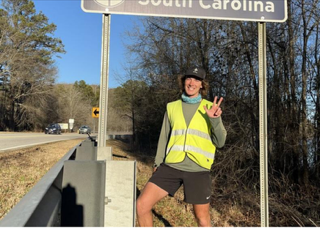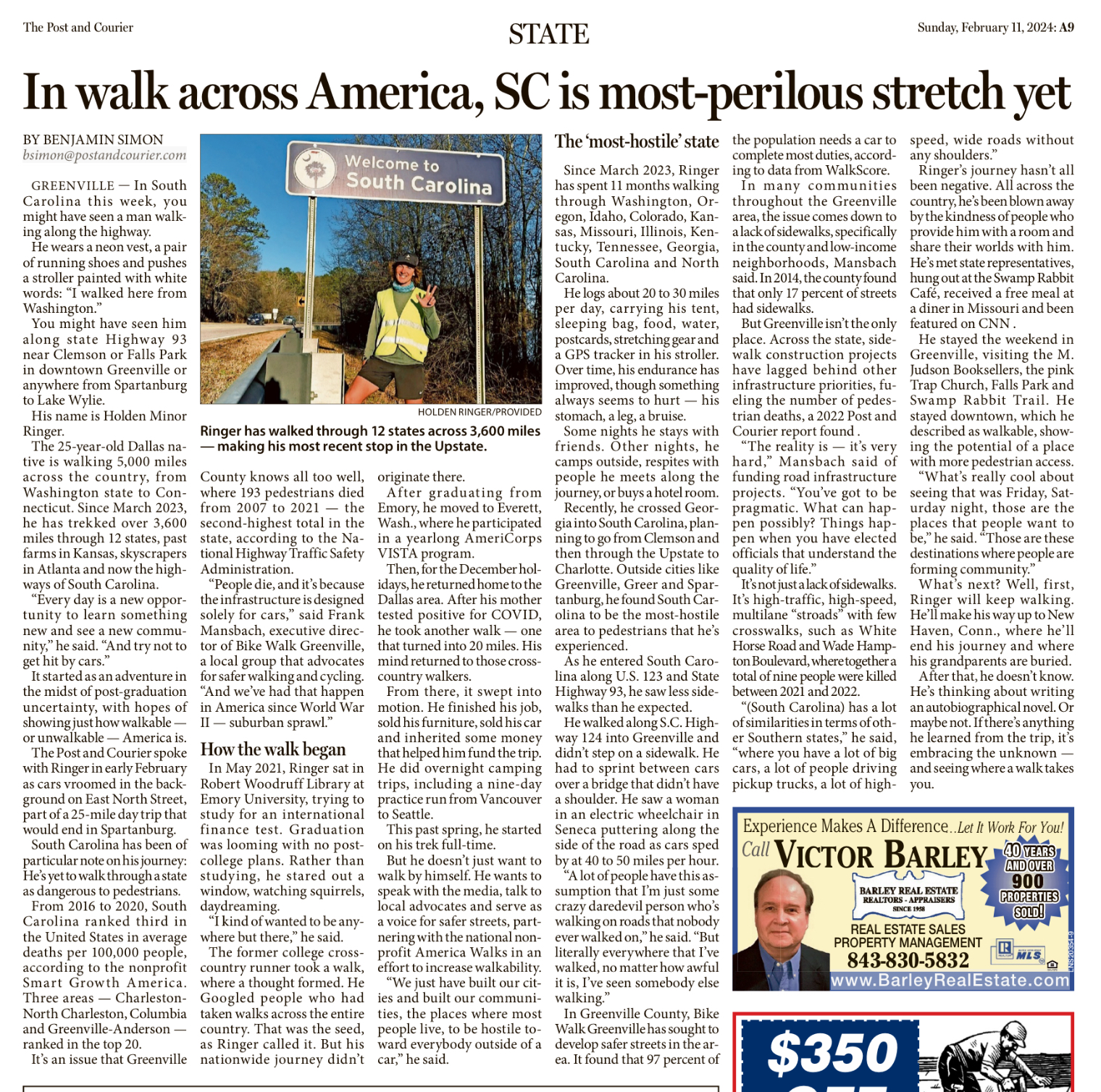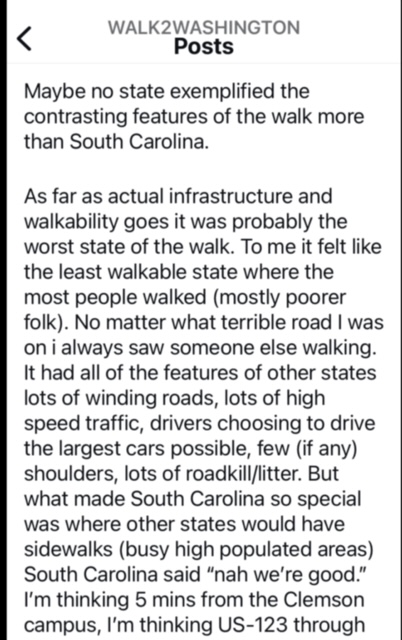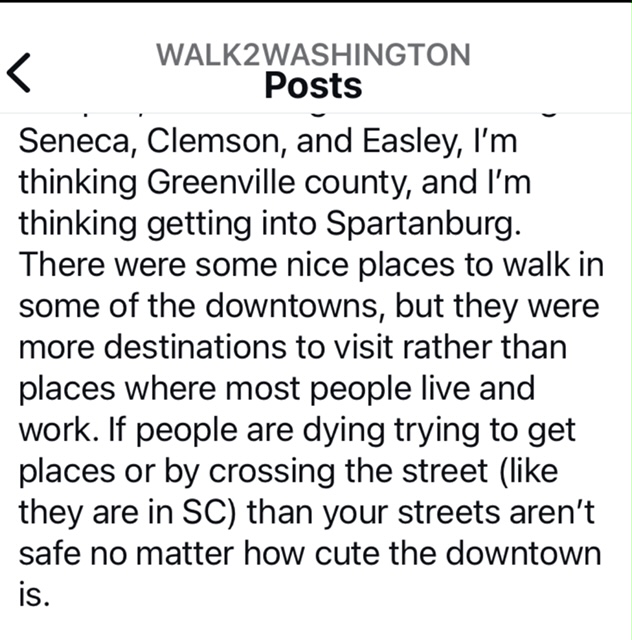By Benjamin Simon bsimon@postandcourier.com
Published Fri Feb 09, 2024 5:00 AM EST

GREENVILLE — In South Carolina this week, you might have seen a man walking along the highway.
He wears a neon vest, a pair of running shoes and pushes a stroller painted with white words: “I walked here from Washington.”
You might have seen him along state Highway 93 near Clemson or Falls Park in downtown Greenville or anywhere from Spartanburg to Lake Wylie.
His name is Holden Minor Ringer.
The 25-year-old Dallas native is walking 5,000 miles across the country, from Washington state to Connecticut. Since March 2023, he has trekked over 3,600 miles through 12 states, past farms in Kansas, skyscrapers in Atlanta and now the highways of South Carolina.
“Every day is a new opportunity to learn something new and see a new community,” he said. “And try not to get hit by cars.”
It started as an adventure in the midst of post-graduation uncertainty, with hopes of showing just how walkable — or unwalkable — America is.
The Post and Courier spoke with Ringer in early February as cars vroomed in the background on East North Street, part of a 25-mile day trip that would end in Spartanburg.
South Carolina has been of particular note on his journey: He’s yet to walk through a state as dangerous to pedestrians.
From 2016 to 2020, South Carolina ranked third in the United States in average deaths per 100,000 people, according to the nonprofit Smart Growth America. Three areas — Charleston-North Charleston, Columbia and Greenville-Anderson — ranked in the top 20.
It’s an issue that Greenville County knows all too well, where 193 pedestrians died from 2007 to 2021 — the second-highest total in the state, according to the National Highway Traffic Safety Administration.
“People die, and it’s because the infrastructure is designed solely for cars,” said Frank Mansbach, executive director of Bike Walk Greenville, a local group that advocates for safer walking and cycling. “And we’ve had that happen in America since World War II — suburban sprawl.”
Why are so many pedestrians dying on South Carolina roads?
How a cross-country walk began
In May 2021, Ringer sat in Robert Woodruff Library at Emory University, trying to study for an international finance test. Graduation was looming with no post-college plans. Rather than studying, he stared out a window, watching squirrels, daydreaming.
“I kind of wanted to be anywhere but there,” he said.
The former college cross-country runner took a walk, where a thought formed. He Googled people who had taken walks across the entire country.
That was the seed, as Ringer called it. But his nationwide journey didn’t originate there.
After graduating from Emory, he moved to Everett, Wash., where he participated in a yearlong AmeriCorps VISTA program.
Then, for the December holidays, he returned home to the Dallas area. After his mother tested positive for COVID, he took another walk — one that turned into 20 miles. His mind returned to those cross-country walkers.
From there, it swept into motion. He finished his job, sold his furniture, sold his car and inherited some money that helped him fund the trip. He did overnight camping trips, including a nine-day practice run from Vancouver to Seattle.
This past spring, he started on his trek full-time.
But he doesn’t just want to walk by himself. He wants to speak with the media, talk to local advocates and serve as a voice for safer streets, partnering with the national nonprofit America Walks in an effort to increase walkability.
“We just have built our cities and built our communities, the places where most people live, to be hostile toward everybody outside of a car,” he said.
How one old book took a South Carolina man on a 500-stop, worldwide barbecue journey
The ‘most-hostile’ state
Since March 2023, Ringer has spent 11 months walking through Washington, Oregon, Idaho, Colorado, Kansas, Missouri, Illinois, Kentucky, Tennessee, Georgia, South Carolina and North Carolina.
He logs about 20 to 30 miles per day, carrying his tent, sleeping bag, food, water, postcards, stretching gear and a GPS tracker in his stroller. Over time, his endurance has improved, though something always seems to hurt — his stomach, a leg, a bruise.
Some nights he stays with friends. Other nights, he camps outside, respites with people he meets along the journey, or buys a hotel room.
Recently, he crossed Georgia into South Carolina, planning to go from Clemson and then through the Upstate to Charlotte.
Outside cities like Greenville, Greer and Spartanburg, he found South Carolina to be the most-hostile area to pedestrians that he’s experienced.
As he entered South Carolina along U.S. 123 and State Highway 93, he saw less sidewalks than he expected.
He walked along S.C. Highway 124 into Greenville and didn’t step on a sidewalk. He had to sprint between cars over a bridge that didn’t have a shoulder. He saw a woman in an electric wheelchair in Seneca puttering along the side of the road as cars sped by at 40 to 50 miles per hour.
“A lot of people have this assumption that I’m just some crazy daredevil person who’s walking on roads that nobody ever walked on,” he said. “But literally everywhere that I’ve walked, no matter how awful it is, I’ve seen somebody else walking.”
In Greenville County, Bike Walk Greenville has sought to develop safer streets in the area. It found that 97 percent of the population needs a car to complete most duties, according to data from WalkScore.
Even as pedestrian deaths rise in Charleston area, sidewalks remain low priority
In many communities throughout the Greenville area, the issue comes down to a lack of sidewalks, specifically in the county and low-income neighborhoods, Mansbach said. In 2014, the county found that only 17 percent of streets had sidewalks.
But Greenville isn’t the only place. Across the state, sidewalk construction projects have lagged behind other infrastructure priorities, fueling the number of pedestrian deaths, a 2022 Post and Courier report found.
“The reality is — it’s very hard,” Mansbach said of funding road infrastructure projects. “You’ve got to be pragmatic. What can happen possibly? Things happen when you have elected officials that understand the quality of life.”
It’s not just a lack of sidewalks. It’s high-traffic, high-speed, multilane “stroads” with few crosswalks, such as White Horse Road and Wade Hampton Boulevard, where together a total of nine people were killed between 2021 and 2022.
Ringer had seen roads like this all across the South.
“(South Carolina) has a lot of similarities in terms of other Southern states,” he said, “where you have a lot of big cars, a lot of people driving pickup trucks, a lot of high-speed, wide roads without any shoulders.”
Ringer’s journey hasn’t all been negative. All across the country, he’s been blown away by the kindness of people who provide him with a room and share their worlds with him. He’s met state representatives, hung out at the Swamp Rabbit Café, received a free meal at a diner in Missouri and been featured on CNN.
He stayed the weekend in Greenville, visiting the M. Judson Booksellers, the pink Trap Church, Falls Park and Swamp Rabbit Trail. He stayed downtown, which he described as walkable, showing the potential of a place with more pedestrian access.
“What’s really cool about seeing that was Friday, Saturday night, those are the places that people want to be,” he said. “Those are these destinations where people are forming community.”
What’s next? Well, first, Ringer will keep walking. He’ll make his way up to New Haven, Conn., where he’ll end his journey and where his grandparents are buried.
After that, he doesn’t know. He’s thinking about writing an autobiographical novel. Or maybe not. If there’s anything he learned from the trip, it’s embracing the unknown — and seeing where a walk takes you.
Sunday February 11, 2024 print edition
We were pleased to see that this statewide issue was featured in the Sunday paper.
Hopefully this story will result in more awareness by our state legislators that significantly more funding is needed to make the 41,000 miles of SCDOT maintained roads safer for the pedestrians that live along these roads.

Walk2Washington on Instagram
Holden Ringer has been posting on Instagram every day of his walk. On February 11, 2024 he provided his observations about walking in South Carolina:


